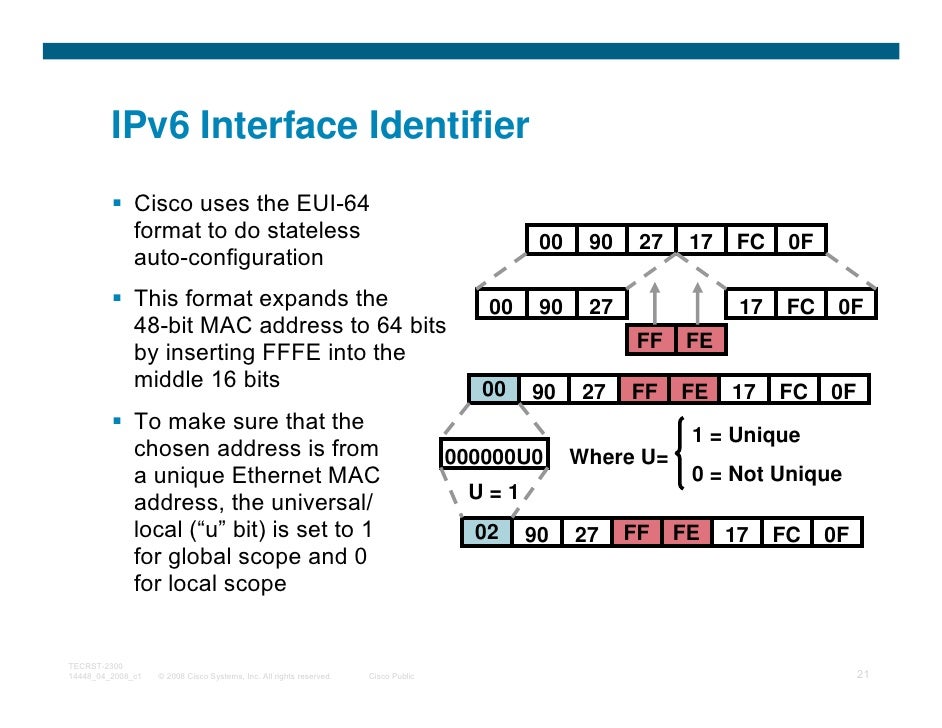1.15.e Modified EUI 64. EUI-64 (extended unique identifier) is a way of auto generating the 'host' part of a IPv6 address. This is done by the following steps: Split the 12 hex digit MAC address into two halves. Insert FFFE in between the two. Invert the seventh bit of the interface ID. 1.15.f Autoconfiguration.
- Modified EUI-64 format interface identifiers are formed by inverting the 'u' bit (universal/local bit in IEEE EUI-64 terminology) when forming the interface identifier from IEEE EUI-64 identifiers. In the resulting Modified EUI-64 format, the 'u' bit is set to one (1) to indicate universal scope, and it is set to zero (0) to indicate local scope.
- The result is a modified EUI-64 address format of 020C29FFFE1CF2F7. To complete the autoconfiguration IPv6 address, the subnet prefix of FE80::/64 is then prepended to the interface identifier resulting in a 128-bit link-local address.

The second part of an IPv6 unicast or anycast address is typically a 64-bit interface identifier used to identify a host's network interface. A 64-bit interface ID is created by inserting the hex value of FFFE in the middle of the MAC address of the network card. Also, the 7th Bit in the first byte is flipped to a binary 1 (if the 7th bit is set to 0 it means that the MAC address is a burned-in MAC address). When this is done, the interface ID is commonly called the modified extended unique identifier 64 (EUI-64).
For example, if the MAC address of a nework card is 00:BB:CC:DD:11:22 the interface ID would be 02BBCCFFFEDD1122.
Modified Eui 64 Vs
Why is that so?
Well, first we need to flip the seventh bit from 0 to 1. MAC addresses are in hex format. The binary format of the MAC address looks like this:
We need to flip the seventh bit:
Now we have this address in hex:
Next we need to insert FFFE in the middle of the address listed above:
So, the interface ID is now 02BB:CCFF:FEDD:1122.
Another example, this time with the MAC address of 00000C432A35.
1. Convert to binary and flip the seventh bit to one:
binary: 0000 0010 0000 0000 0000 1100 0100 0011 0010 1010 0011 0101 Iphone 12 13.
2. Convert back to hex:
hex: 02000C432A35
3. Insert FFFE in the middle:
interface ID: 02000CFFFE432A35
Modified EUI-64 Addressing
Modified Extended Unique Identifier 64 (EUI-64) is the process that allows a host to assign itself a unique IPv6 address. The host's MAC address is converted into a 64-bit identifier, called a Modified EUI-64, and this value is appended to a 64-bit network prefix learned by other means. This feature is an enhancement over IPv4 because it eliminates the need for manual configuration or DHCP. The IPv6 Modified EUI-64 format address is created based on the 48-bit MAC address of the interface. The MAC address is first separated into two 24-bit groups, the first being the OUI (organizationally unique identifier) and the other being NIC-specific. The 16-bit value of FFFE is then inserted between these two 24-bit groups to form the 64-bit EUI address. IEEE has chosen FFFE as a reserved value that can only appear in EUI-64 generated from the EUI-48 MAC address.
Finally, the seventh bit from the left, or the universal/local (U/L) bit, needs to be inverted. This process can be seen in Figure 11-2. This bit identifies whether this Modified EUI-64 interface identifier is officially assigned or locally generated; in other words, whether it is universally or locally administered. If it is 0, the address is locally administered; if it is 1, the address is globally unique. It is worth noticing that in the original OUI portion, the globally unique addresses assigned by the IEEE have their U/L bit always set to 0, whereas locally created addresses have it set to 1. In other words, the meaning of the U/L bit in the Modified EUI-64 is inverted when compared to the meaning assigned by IEEE. This is the reason for calling this address the Modified EUI-64. Therefore, when the bit is inverted, it maintains its original value.
Using EUI-64 AddressingAt the command line, the configuration of Modified EUI-64 addressing is very simple, but we are interested in the outcome rather than just the process of implementation here. Therefore, we will first look to see what the 48-bit MAC address of the FastEthernet0/1 interface is:
R1#sh int e0/0 | i bia
Hardware is AmdP2, address is aabb.cc00.0100 (bia aabb.cc00.0100)
R1#
You can see that the address is aabb.cc00.0100, so let's first break this address up into two 24-bit groups.:
aabb.cc 00.0100
Modified Eui 64 Bit
Now we will insert the prescribed FFFE value to get a 64-bit product:
aabb.cc FF.FE 00.0100 What is meant by ms excel.
Modified Eui 64 Gt
Finally, we will invert the seventh least significant bit in the second byte of this value. Raging bull online casino. The second byte in this address is the second A, which would be 00001010 if we converted it to decimal. We see that the seventh zero in binary stream is 1, and we will invert it to a 0. This means that the value would now be a binary 00001000, which would be a value of 8 if we converted it back to hexadecimal. This means that the modified value would now be the following:
Modified Eui 64 Super
a8bb:ccff:fe00:0100
This is the Modified EUI-64 value that will be assigned when we configure the command under R1's FastEthernet0/1 interface. You can see that here:
Note also the automation of the link local address; same principle, uses FE80::
